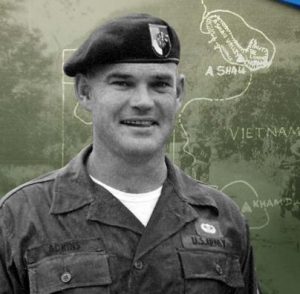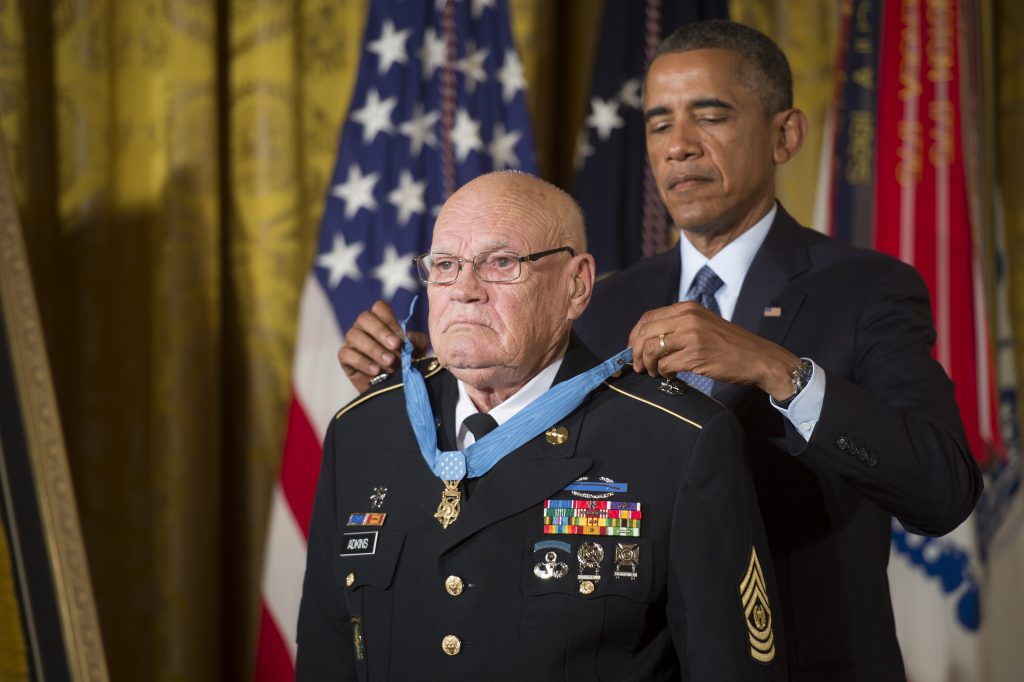 Bennie Adkins was drafted into the Army Dec. 5, 1956, at the age of 22, from Waurika, Oklahoma. Upon completion of initial training at Fort Bliss, Texas, he was assigned as an Administrative Clerk-Typist to a garrison unit in Giessen, Germany, with a follow-on assignment to the 2nd Infantry Division, at Fort Benning, Georgia. After attending Airborne School, he volunteered for Special Forces, in 1961. He served with the Special Forces for more than 13 years with the 7th, 3rd, 6th and 5th Special Forces Groups (Airborne).
Bennie Adkins was drafted into the Army Dec. 5, 1956, at the age of 22, from Waurika, Oklahoma. Upon completion of initial training at Fort Bliss, Texas, he was assigned as an Administrative Clerk-Typist to a garrison unit in Giessen, Germany, with a follow-on assignment to the 2nd Infantry Division, at Fort Benning, Georgia. After attending Airborne School, he volunteered for Special Forces, in 1961. He served with the Special Forces for more than 13 years with the 7th, 3rd, 6th and 5th Special Forces Groups (Airborne).
While in the Special Forces, he deployed to the Republic of Vietnam for three non-consecutive tours. His first tour in the Republic of Vietnam lasted from February 1963 to August 1963. His second tour of duty in Vietnam lasted from September 1965 to September 1966. His final Vietnam tour lasted from January 1971 through December 1971.
After Vietnam, Adkins served as First Sergeant for the Army Garrison Communications Command in Fort Huachuca, Arizona. He then joined Class #3 of the Army Sergeants Major Academy in El Paso, Texas. After graduation, Adkins served with the Special Forces at Fort Bragg, North Carolina, and then led training at Fort Sherman’s Jungle School in the Panama Canal Zone. He retired from the Army, in 1978.
Adkins earned his bachelor’s degree from Troy State University, in 1979. He earned his Master’s Degree in Education, in 1982, and then, a second Master’s Degree in Management, in 1988, all from Troy State University. Simultaneous to pursuing his degree programs, he established the Adkins Accounting Service, Inc., in Auburn, Alabama, serving as its CEO for 22 years. He also taught night classes at Alabama’s Southern Union Junior College, for 10 years, and at Auburn University, for six years. Adkins has been married to his wife, Mary, for 59 years, and together they have raised five children.
Adkins’ previous awards and decorations include the Distinguished Service Cross, Silver Star, Bronze Star Medal with one Bronze Oak Leaf Cluster and “V” Device, the Purple Heart with two Bronze Oak Leaf Clusters, the Army Commendation Medal, the Army Good Conduct Medal with Bronze Clasp and Five Loops, the National Defense Service Medal, the Armed Forces Expeditionary Medal, the Vietnam Service Medal with one Silver Service Star and one Bronze Service Star, the Presidential Unit Citation, the Meritorious Unit Citation, the Republic of Vietnam Campaign Medal with “60” Device, the Republic of Vietnam Bravery Medal with Brass Star, the Republic of Vietnam Gallantry Cross with Bronze Star, the Republic of Vietnam Gallantry Cross Unit Citation with Palm Device, the Combat Infantryman Badge, the Special Forces Tab, the U.S. Army Master Parachutist Badge, the Vietnamese Parachutist Badge – Two Awards, the Expert Badge with Rifle and Pistol Bars, the Sharpshooter Badge with Carbine Bar, and the Marksman Badge with Machinegun Bar.
CSM Adkins was inducted into the Oklahoma Military Hall of Fame in 2015.

Official Citation
The President of the United States of America, authorized by Act of Congress, March 3, 1863, has awarded in the name of Congress the Medal of Honor to
Sergeant First Class Bennie G. Adkins, United States Army
For conspicuous gallantry and intrepidity at the risk of his life above and beyond the call of duty:
Sergeant First Class Bennie G. Adkins distinguished himself by acts of gallantry and intrepidity at the risk of his life above and beyond the call of duty while serving as an Intelligence Sergeant with Detachment A-102, 5th Special Forces Group, 1st Special Forces, during combat operations against an armed enemy at Camp A Shau, Republic of Vietnam from March 9 to 12, 1966. When the camp was attacked by a large North Vietnamese and Viet Cong force in the early morning hours, Sergeant First Class Adkins rushed through intense enemy fire and manned a mortar position continually adjusting fire for the camp, despite incurring wounds as the mortar pit received several direct hits from enemy mortars. Upon learning that several soldiers were wounded near the center of camp, he temporarily turned the mortar over to another soldier, ran through exploding mortar rounds and dragged several comrades to safety. As the hostile fire subsided, Sergeant First Class Adkins exposed himself to sporadic sniper fire while carrying his wounded comrades to the camp dispensary. When Sergeant First Class Adkins and his group of defenders came under heavy small arms fire from members of the Civilian Irregular Defense Group that had defected to fight with the North Vietnamese, he maneuvered outside the camp to evacuate a seriously wounded American and draw fire all the while successfully covering the rescue. When a resupply air drop landed outside of the camp perimeter, Sergeant First Class Adkins, again, moved outside of the camp walls to retrieve the much needed supplies. During the early morning hours of March 10, 1966 enemy forces launched their main attack and within two hours, Sergeant First Class Adkins was the only man firing a mortar weapon. When all mortar rounds were expended, Sergeant First Class Adkins began placing effective recoilless rifle fire upon enemy positions. Despite receiving additional wounds from enemy rounds exploding on his position, Sergeant First Class Adkins fought off intense waves of attacking Viet Cong. Sergeant First Class Adkins eliminated numerous insurgents with small arms fire after withdrawing to a communications bunker with several soldiers. Running extremely low on ammunition, he returned to the mortar pit, gathered vital ammunition and ran through intense fire back to the bunker. After being ordered to evacuate the camp, Sergeant First Class Adkins and a small group of soldiers destroyed all signal equipment and classified documents, dug their way out of the rear of the bunker and fought their way out of the camp. While carrying a wounded soldier to the extraction point he learned that the last helicopter had already departed. Sergeant First Class Adkins led the group while evading the enemy until they were rescued by helicopter on March 12, 1966. During the thirty eight hour battle and forty eight hours of escape and evasion, fighting with mortars, machine guns, recoilless rifles, small arms, and hand grenades, it was estimated that Sergeant First Class Adkins killed between one hundred thirty five and one hundred seventy five of the enemy while sustaining eighteen different wounds to his body. Sergeant First Class Adkins’ extraordinary heroism and selflessness above and beyond the call of duty are in keeping with the highest traditions of the military service and reflect great credit upon himself, Detachment A-102, 5th Special Forces Group, 1st Special Forces and the United States Army.
